I have been planning for ages to make some Goda sheera (goda =sweet in Marathi , my mother tongue and sheera stands for a sweet preparation made using Semolina as the primary ingredient ). I wanted to prepare this for Holi but was too lazy to do it but on Gudi Padwa, which is the Maharashtrian New year, I decided to be a good girl and prepare this sweet dish and offer it to my favourite god Ganpati Bappa:)
I love using milk and mashed bananas as it reminds me of the way my elder Sister prepares it and also of the many Satyanarayan Pooja Prasad (Prasad = offering made to god in the form of food etc) that I have greedily gobbled up all my life back home in India. My mother though prefers to prepare this dish using a mixture of sugar dissolved in water to add a sweet taste. Any way you choose to prepare it, I assure you it is a hugely satisfying experience preparing it and gobbling it afterwards 🙂
It would be unfair to throw Indian terms at my non Indian readers so , Gudi Padwa is a festival wherein we Maharashtrians celebrate the end of the harvest season and welcome a brand new year with the Hindu Calender. Satanarayan Pooja is a Hindu ritual of worship performed to celebrate new beginnings like a wedding, a housewarming or during the annual Ganesh Festival. It requires the Man and the Lady of the house to perform an elaborate offering to god and the beautiful part of the pooja or the ritual is the Katha (Katha simply means story in Marathi) as it takes the listener on a journey through tales that define our religion. The ultimate offering of love for god at the end of this ritual is called a Prasad and is almost always Sheera. Please click on the hyperlinks to enjoy reading in detail about the terms used. I thank all contributors to Wikipedia for providing such useful and beautifully written information. Oh yes, and the most fun part of Gudi Padwa is the Gudi, it is basically a long stick covered in shiny wrapping paper and a decorative piece of cloth is placed on the top and an inverted ”gadoo” or a stainless glass of a particular shape is placed over it or a brass container which is used for poojas and is again a very auspicious piece of the ritual. The swastika symbol is made on it using bright red kumkum, then this is wrapped with a garland of fresh marigolds and bright green leaves of the mango tree and also a garland made from ” Batashe” which is a white leaf-like thing made from concentrated sugar syrup and strung onto a string and made into a garland. This is then perched on the balcony and worshipped and kept on display for all to see, it is quite a sight to see colourful ”gudi’s” swaying outside everyone’s windows and balconies.
I had to make mine this year using an unused shower curtain rod, golden wrapping paper recycled from Christmas, a steel bowl instead of the traditional glass and a bright red stole instead of the usual auspicious colours of green or gold! Anyway, this is what it looked like :), am quite proud of it really!
Below I have chosen 2 images from google that I feel are really good and stunningly clear images and really capture the spirit of the festival, the first of a couple dressed all traditionally and with the beautiful Gudi being worshipped using a well-decorated thali (plate containing several items for performing the ritual) and the second image is of the sexy Ms Isha Koppikar looking like a million bucks and the Gudi looks lovely as well!
Pic 1: Image courtesy iDiva dot com
Pic 2: Image Courtesy Click here
Ok ! so now, let me try to put down here the recipe in a simple and easy-peasy manner.
Preparation time: Approx 45 minutes Serves:4
Ingredients :
- Semolina /Rava/Suji – I use fine rava as it is what I find is best for this recipe. approximately 2 small watis or ramekins.
- Ghee – plenty!
- Raisins – a handful
- Badam/Almonds – again a handful
- Saffron/Kesar/Zafran – a small pinch just to add colour and pomp!
- Cashewneuts/Kaju/Kajoo – if you like them, not necessary) – a generous handful without the peel and unsalted.
- Milk about 200 ml
- One ripe Banana
- Elaichi/ Green Cardamom – about 6-8 – open them and crush the brown seeds to make a powder using a mortar pestle we will also use the green outer cover to add a distinctive aroma to the recipe :), sounds so romantic doesn’t it ( err well …)
- Sugar – I use granulated white sugar, and take 2 – 2.5 measures of a small bowl, actually, the proportion is always 2:1 for the Semolina: Sugar for this dish so choose the quantity accordingly.
Method :
- Boil some water and add into a small bowl, add the almonds, this will make it easy to peel off the skin. Soak some raisins in lukewarm water so that they absorb water and can be dunked into the semolina at a later stage.
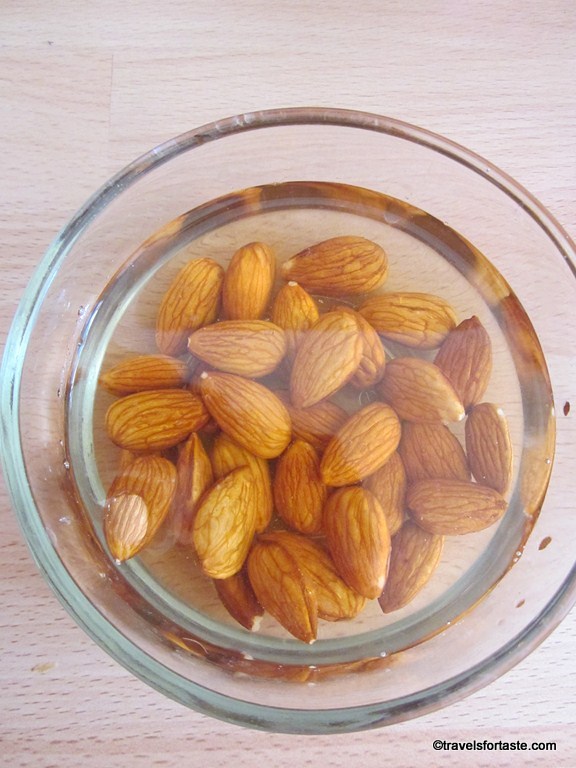

- Add the Saffron strands ever so carefully to a small bowl of water so as to allow the beautiful golden orange colour to disperse into the water.
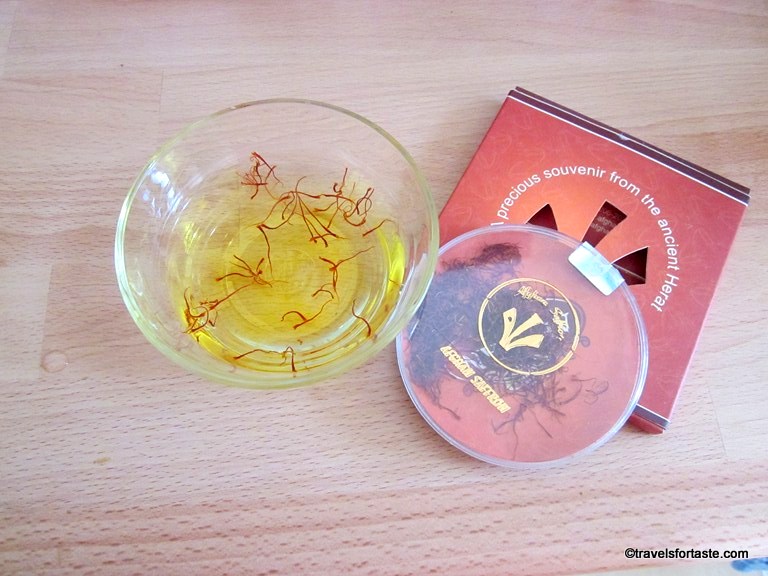

- Take 2 bowl fulls of Semolina and add to a pan and constantly stir it until it turns a light brown colour, if you do not keep stirring or put the pan on a very high flame it might burn and we don’t want that do we? Also, I use a rather heavy bottom pan to ensure that the heat spreads evenly and that the Semolina browns well.

- This is how it looks before we brown it :

- This is how it will look after stirring for a while :

- This is how it will look when it is done and ready for the next stage,i.e to be added to the ghee:

- Remove the pan from the flame and keep the Semolina aside .Now take 2-4 large tablespoons of ghee (Clarified Butter) in a vessel and warm it on a low flame, be very carefull when frying with ghee as GHEE heats up very fast and anything unattended inside the hot ghee can char easily. When the ghee is warming up add the cashew nuts first and wait for them to start browning, then add the remaining raisins – not the ones which are kept soaking in water ! The strong aroma of the warm Semolina , the beautiful smell of desi ghee and the in-your-face tasty aroma of the fried cashews will assault your senses in the most pleasant way and fill up your kitchen with an almost auspicious atmosphere, it’s when this happens that one truly feels festive from within and it is also at such moments I have massive nostalgia attacks and realise how deeply coded our childhood memories are and how much a part of our memories are made up of familiar sights and sounds. I oftentimes find life in the western world paler, less colourful and too quite compared to the pomp , blast of colours and festivity that make up India …sighhhh !



- The cashew nuts and raisins turn a golden hue as seen in the picture above and the raisins puff up quite a bit due to the heat of the ghee,be careful not to overdo the raisins as they are akin to tiny missiles filled with boiling hot oil and if they burst , you can get serious burns …booooo! The kitchen is quite a dangerous place for the uninitiated isn’t it ?!
- Ok, while the cashew nuts are being processed , take a small vessel and add the 200 to 250 ml milk on a low flame, add the sugar and dissolve, stirring till it completely dissolves, do not allow the milk to boil but reduce it on a low flame, add the crushed green cardamom powder and the outer green cover. Add some of the saffron and the water in which it was soaked as well, keep some for adding into the mixture later. When this mixture is on the flame , it gives out an unmistakable aroma of sweet sugary milk and I can almost feel my teeth sink into the soft sheera and mentally I am biting into the fried cashews and the yummee soft Banana bits that play hide and seek with my tongue as I devour the sheera – AAHHH , anyway , don’t allow that to happen as it is considered wrong to savor the ”Prasad” before the Almighty is offered some for ”bhog” or in simple words god has been offered the sweet dish and it is assumed that he has symbolically consumed our offering and blessed us with all that we wish and desire for 🙂



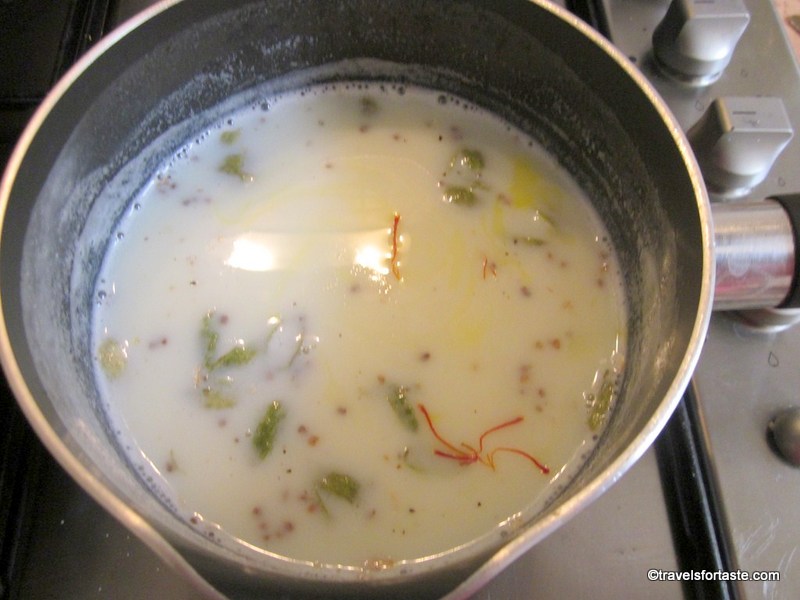
- When the cashew nuts and the raisins have been fried, add the semolina slowly in the hot ghee mixture, stirring continuously to prevent any lumps from forming and also to ensure that the semolina soaks up the ghee properly.



- Once all the Semolina is mixed well into the ghee and fried dry fruit mix it will look like the picture above, then add the remaining saffron and water in which it was soaked to the mixture.

- Then add the roughly mashed banana pieces to the semolina mixture.

- When the sugar has completely dissolved and the milk has reduced a little, it is ready to be added to the semolina mixture. Add it stirring slowly, it will look like the picture below immediately after adding the milk and sugar into it.
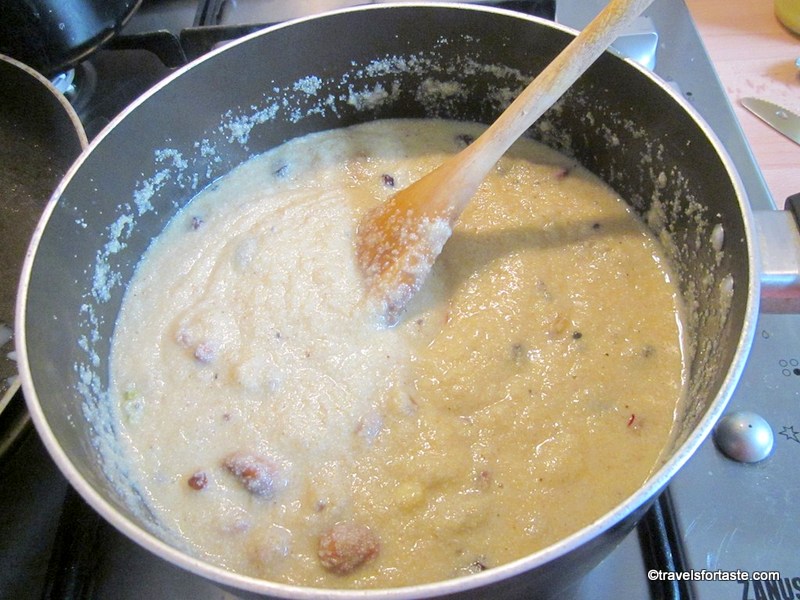
- Stir a bit more and here is what it will look like now:

- For the smallest possible time , cover the mixture above on the lowest possible flame , it is then ready to be served, now add the almonds to season over the top , peel off the skin , thanks to the warm water they will come off very easily and then just halve the almonds or if you want to be very artistic and have some time cut the almonds into longish thin strips ,anyway which they add a definite crunch to the sweet dish and I love that ,you dish will now look like this :

- Take some of this beautiful dish and serve into a small bowl to offer to the Ganpati Bappa – who has been made to shine and sparkle for the day and place it in front of him , hands folded ask for his blessings and wait for sometime till you are convinced he’s had some of the offering or ”Prasad”.

Aaah , now just look at the cute Bappa 🙂
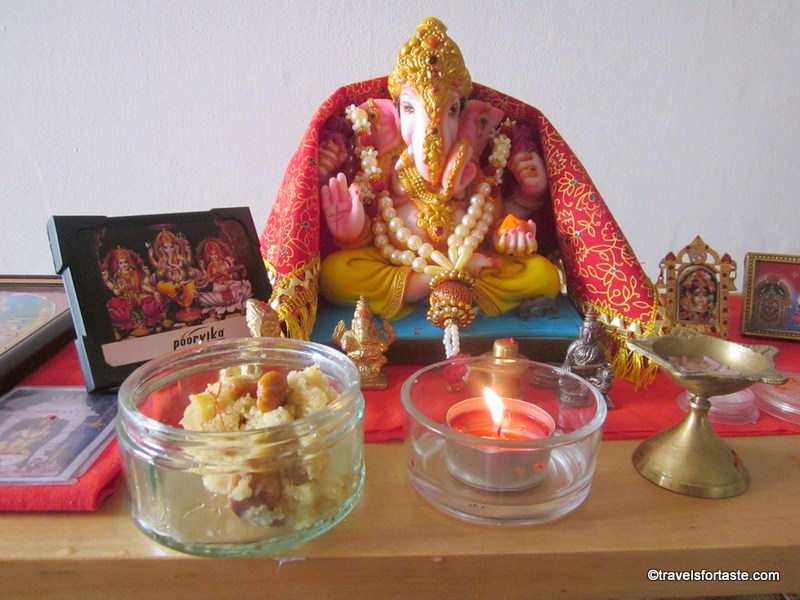
HAPPY EATING ALL YE READERS who attempt to make it, do let me know any feedback 🙂 all good of course 😉
Learn how to cook western coastal Indian cuisine from the C.K.P community with my easy-to-follow recipes.
Find below a list of Indian recipes on my blog, some traditional, some fusion, and many regional favourites!
- Valache Birdhe – (वालाचे बिरडे) – Made in a typical C.K.P way
- Fresh dill and yellow moong daal recipe
- CKP Surmai curry
- Pompfret fry
- Konbichi khichadi – Prawn khichadi
- Vaangayche Bharit/ Smoked stuffed Aubergine ( Eggplant/Brinjal) in a thick gravy/ Baingan ka bharta
- Kairi Panhe/ Aam ka panha – Raw mango summer drink
- Cauliflower- vatana bhaji – cauliflower and green peas vegetarian side dish
- Podhnichi khichadi
- Akkha masoor aamti CKP style / Whole red lentils with skin curry recipe
- Achari Mutton curry
- Spicy Chicken curry
- Egg curry
- Kadhi – fusion of Punjabi and Gujrati kadhi recipes with vadi’s
- Upma
- Gujrati Kadhi
- Shahi Khichadi
- Sweetcorn and paneer bhaji/sabzi (vegetable side dish)
- Tomato and coconut chutney
- Steamed Idli batter
- Ragi (Finger Millet) and blueberry pancakes
- Masala egg omlette
- Chicken tikka masala
- Tikka masala curry paste
- Tawa chicken Frankie roll
- Chai concentrate
- Grated carrot salad
- Strawberry flavoured shrikhand


